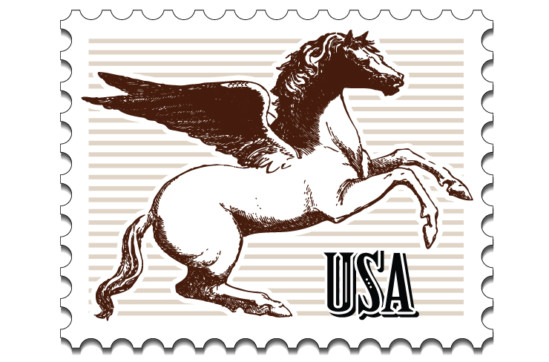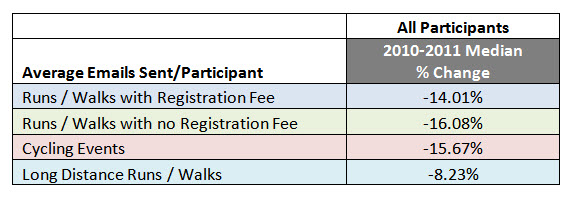Raising Money Using Social Media: Five Ways to Support Peer-to-Peer Fundraisers

In 1860, the Pony Express was the fastest means to communicate from coast to coast in the United States. A letter went to Missouri by train, then a Pony Express rider picked it up and rode hell bent for leather across the plains and mountains, reaching San Francisco in 10 days or less. Within 18 months, the telegraph came along, replacing the brave young men racing across the Western Plains on horseback.
This bit of history came to mind as I looked at the email results within our soon-to-be-released Blackbaud Peer-to-Peer Benchmark Report (look for it next month). We know a key to successful peer-to-peer (P2P) events is participants sending emails to friends and family. And yet this year’s report shows a general decline in the number of emails sent by fundraisers through the online tools.

Nonetheless, we saw signs that P2P participants continue to expand their use of online fundraising tools:
- Total funds raised online were up in our study, anywhere from 10 to 15%, depending on the event category.
- Average online gift size increased slightly as well.
If online activity continues to expand, this leads me to speculate if, like the Pony Express, other means of communication are supplanting … or at least supplementing email as the means participants use to solicit donations.
For at least 10 years, online email tools (usually bundled into the P2P website software) have been the state of the art. These email tools gave us a huge shift in productivity from paper pledge sheets and collecting checks directly from friends and family. While I don’t think email is dead, it’s clear that event participants are migrating to new tools, specifically social media tools, in their fundraising efforts.
This opens up lots of possibilities for nonprofit organizations to support P2P event fundraisers in their use of social media, including the following:
- Savvy event coordinators are “following the money” and promoting fundraisers’ use of tools like Facebook, Twitter, YouTube, Pinterest, Instagram, and QR codes as they strive to raise money for the cause. Previous Blackbaud studies have found that P2P fundraisers using social networking tools like Facebook, Twitter and YouTube communicate with their networks more regularly and send more messages than those who use email alone. This blended approach resulted up to 40% higher fundraising results for those participants.
- Some P2P software systems like Friends Asking Friends incorporate a suite of social sharing tools and a mobile app for use by participants with smartphones. Nonprofits using other P2P systems can benefit from add-on tools like Chorus Connect Mobile Fundraising, which provides a broad range of social sharing features. The beauty of built-in tools can be greater ability to report on the source of donations – so we know what’s working.
- Add coaching on use of social media to your event communication strategy. Fundraising support emails, group webinars or phone calls, and online participant tips sheets should be expanded to include tips for a using social media to fundraise. Some things to remember:
- Address a variety of popular media; some people live on Facebook but don’t touch Twitter, while others might do all their fundraising via comical YouTube videos that they socialize on Twitter.
- Educate participants on the social media tools available to them in their Participant Center / HQ or add-on tools that they might have access to use.
- Offer very specific examples for how fundraisers can use social media to fundraise. Just like in the “participant center” or “HQ” we provide email templates to help fundraisers write their pitch, offer templates for Facebook status updates and Twitter tweets. Here are some resources for inspiration:
- Blackbaud’s Nancy Palo offers very specific Fundraising on Facebook Tips for Peer-to-Peer Fundraisers in a recent blog post.
- The staff of the AIDS Walk Boston & 5K Run offers a generous array of samples of effective Tweets and status updates that have been “vetted for accuracy” in describing the urgency of the mission:
- Why @aidswalkboston? 24% of new #HIV infections occur in people 13-24 years old. http://bit.ly/awb5k #AWB5K
- @AIDSAction serves 1-in-6 in MA with HIV diagnosis. Support their work at http://bit.ly/awb5k #AWB5K
- The Avon Walk for Breast Cancer gets similarly specific with its tips for fundraising using social networks ranging from Facebook to YouTube. Anyone with a cell phone video recorder and a bit of tech savvy (or access to a 12 year old) can create a decent YouTube channel to promote their fundraiser using these tips.
- Emphasize variety. Abandoning email and/or person-to-person conversations as a means of communication can be short sighted, even if a well-connected few do all of their fundraising outreach via Facebook. As mentioned above, top fundraisers spread their efforts across a variety of means of communication, from several different social media tools to email and personal connections. I haven’t seen anyone reviving the Pony Express for fundraisers lately, but we don’t want to rule out a communication channel just because no one else is doing it!
